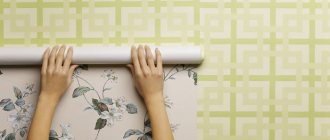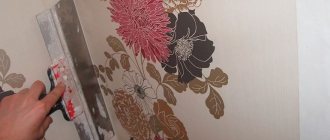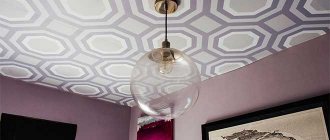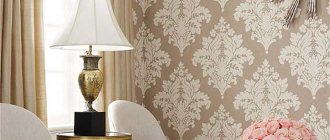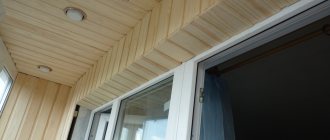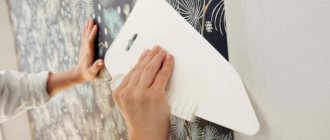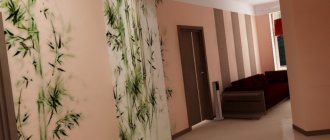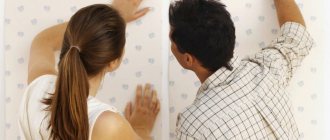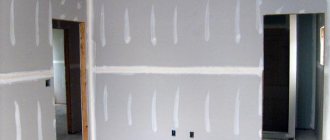Tile countertop, tiled countertop
There is a need to tile the countertop. This option was supposed to be (criticism, advice?) 1. Take a standard tabletop (23 mm chipboard). A tabletop, but not plywood or just chipboard, simply because tabletops are sold at hand, but everything else still needs to be brought. Plus, the standard tabletop fits perfectly, no need to trim anything. 2 On top of the liquid nails we glue one layer of moisture-resistant gypsum plasterboard, plus we fasten the gypsum plasterboard with self-tapping screws. GVL, but not DSP already because GVL is available. 4. Glue 10x10 porcelain tiles onto Flexleber on top. 5. Grout it with LITOCHROM STARLIKE epoxy grout. This option was assumed and it remains in force for now (therefore criticism and advice are welcome). However. The other day they brought me kitchen furniture and the company seems to have collapsed. Along with the furniture they brought a tabletop, which I did not order and did not pay for at all. At the same time, the freight forwarders even forgot to take a receipt stating that the goods were delivered. Well, I modestly remained silent. Well, I think the company will not become poor, because when ordering furniture, after calculating the price, we subtracted the cost of the tabletop from the price, it turned out to be minus 7,000 (SEVEN) thousand, despite the fact that prices for tabletops of this size (3 meters with kopecks) start from 900 rubles. (23 mm) up to 1800 r (38 mm). So, they brought tabletops 38 mm thick. If you put GVL (10 mm) on top of all this, plus tiles (another 10 mm), then you get a tabletop 60 mm thick, which seems a bit thick. Or not, does anyone have any experience or thoughts? Kitchen in the so-called “Castle style”, a version of a similar kitchen below. And so. What if you don’t bother with GVL, but just glue the tiles onto this laminated countertop with liquid nails? The grout is the same. Do you think it will hold up?
Slopes are different!
There are different slopes: door and window; made using plasterboard or simply plastered; covered with wallpaper, laminate, tiled, simply puttied and painted. I will tell you about the types of slopes that I have at home, justifying their use in this form. Let's start with the general:
All the slopes in our house are made using plasterboard: a layer of rodbunt is applied to the primed surface (it is used as glue), and a pre-prepared sheet of moisture-resistant plasterboard is glued onto it. To strengthen this structure, we used a metal corner, which was also “glued” with a rod band. We glued it only to the outer corners, those that, as they say, can be caught with a shoulder or torn down with a foot or a toy (in our case). We prime the almost finished “rough” slopes again, putty, clean, putty (if necessary) and prime again. Now the slope is ready, all that remains is to decorate it. And now the most interesting part begins: We only have a door to the combined bathroom, but there are no other interior doors (due to financial difficulties after the renovation), and no one knows when they will appear, maybe in a month, or maybe in a month. year. And living with unpasted, unfinished door slopes waiting for doors, with our little children, is simply not realistic: in a couple of days they would have “removed” all the wallpaper for us, peeled off everything they could: it would be a sin not to pull and pick where something came unstuck or began to slowly come off.
Pasting methods
If you previously had the simplest paper sheets glued on, then removing them from the wall is easy:
- You need to moisten the surface generously with water and wait about 15-20 minutes.
- Then, using smooth movements, starting from the ceiling, remove the previous coating.
- If the walls were previously covered with waterproof materials, you will have to work with a spatula.
Find out how to easily and quickly remove vinyl, liquid and photo wallpaper from walls).
Previously, we started wallpapering from the window .
This is due to the fact that the wallpaper was glued overlapping each other. To hide unwanted defects, all work began from the most illuminated place in the room. But there is also an equally popular method of gluing from the door (where and how to start gluing wallpaper?). It is suitable for applying vertical stripes to the surface. The slopes of all doors are strictly proportional and have the greatest vertical height. It’s easier to focus on the doorway in order to stick the strips evenly.
Now there are no such problems with joining the canvases, so it is better to choose the simplest method and start pasting the walls from the doorway (how to join wallpaper correctly?).
Around the doorway
- First you need to cut the strips to the desired length. Then you need to attach it to the already pasted canvas without a gap.
- Make diagonal cuts where the door casing is attached. Remove the excess part of the wallpaper, otherwise it will interfere with the pasting. Don't leave too much margin at the top or bottom - it will be very difficult to hide them behind the door trim.
- Press the material firmly against the wall. Start smoothing with a roller, starting strictly from the center, using smooth movements.
- If there is still excess left, then get rid of it with a stationery knife. Please note that the blade should be as sharp as possible, since wet coatings are not easy to trim.
- Remove excess glue with a sponge or rag. If the wallpaper is not paper, you can moisten it a little with water. To completely hide the excess under the casing and not leave any gaps, it is enough to make an allowance of 2-2.5 cm.
- To push the wallpaper under the casing, use a special wide metal spatula.
On the slopes
Having reached the pasting of the door slopes, hurry up and immediately glue the next panel. It is necessary to bring the wallpaper to the slope so that the canvas overlaps the door opening. It will be much more convenient if the width of the roll is wider than the slope . If you can’t do this, then you need to stick a narrow strip of wallpaper on the open area. Measurements must be taken very accurately so that the strip is glued end to end.
It is worth considering that the coating should extend slightly onto the door frame.
It is necessary to cut the canvas vertically so that it extends a little further than the corner line, about 2-3 cm , and cut off the excess. On the opposite side of the door slope we do the same.
All that remains is to paste over the area in the middle of the doorway. It must be accurately measured and a piece of the required size cut from the roll. We must remember that the wallpaper should extend onto the inside of the slope and onto the door frame.
Below is a visual video about how to glue wallpaper on slopes:
price for wallpapering
Gentlemen, masters, the following question arose: when estimating the cost of work for wallpapering, how to evaluate openings (windows, doors)?
where the wallpaper does not stick, but pasting such places also requires labor. It’s just that the price varies depending on the complexity of the pasting. Ours ranges from 100 to one hundred and eighty.. exclusive ones are even more expensive
In linear meters, this is clear to the horse. In this case, the areas of windows and doors are discarded. Otherwise, you can also charge for floors that are not painted)
ssvkrym wrote: how to evaluate openings (door windows)? where the wallpaper doesn't stick
Labor without art is barbarism!
but you also need to spend time and effort on pasting the window; for me, it’s easier to glue a strip of wallpaper a meter wide than to go around the window with wallpaper.
The worker wrote: In linear meters, this is clear to the horse.
ssvkrym wrote: what about windows? to count or not these, for example, two squares of a window?
why consider that they didn’t paste over
ssvkrym wrote: or not to count these, for example, two squares of a window?
No. The area of the walls is calculated, then the area of all openings is subtracted from it.
ssvkrym wrote: but pasting such places also requires labor
Which ones?
It’s easy to calculate yours by the wallpaper used - the dimensions are indicated on each roll and at the end of the work you can estimate plus or minus a meter... in general, the wall area is the floor area multiplied by 2.5 for a typical housing
Explain. If you cut the wallpaper around the window, then it takes about 2 minutes of labor, but if you cover the slopes with wallpaper (once in my life I glued them with painter’s non-woven fabric), then you can count the squares, or, if the slopes are narrow, then the shoulder straps.
thanks ussur, that means we don’t count openings, which is what I wanted to know.
Let me explain, all this fuss near the window, radiator, trimming for the trim is very tiring.
ssvkrym wrote: I’ll explain, all this fuss near the window, radiator, trimming for the trim is very tiring
I agree, but where can you find such a fool who will pay for this?
It’s easier to increase the price per square meter, but even here you can’t jump much higher than the city average. So, no matter where you go, you can only get money for what is done, and not for the fact that we work hard.
lvov7104 wrote: you can only get money for what is done
I agree, and I only take it for what I did
Yes, it’s not evaluated in any way, you either include it in the total price or not. I don’t understand what’s so difficult about a doorway or window. There is a laser on it and you check the stripes, well, to the extreme plumb line.
Doorways in some cases even make work easier, but a window wall is often the opposite. If the radiator is not removable, there is also more than one, pipes, window sill. Some don't subtract openings.
GKL wrote: There is a laser on it and you check the stripes
laser, that is, but I haven’t used it yet when gluing wallpaper, I think that SUCH precision is not always needed.
The laser gun is a very good assistant when gluing wallpaper - all sorts of inserts, vertical control, corners, etc.
Why are you all fussing? I count without subtracting anything and announce the total. arranges? then we work. and then.. window
1.5. this is from 300 to 500 rubles. If the customer is such a penny-pincher, then you should think hard: do you need it?
Masters, are you interested in the customer’s opinion? (I often speak on behalf of customers here on the forum). In my opinion, this approach is the most correct.
spaceeggs wrote: why are you all petty? I count without subtracting anything and announce the total. arranges? then we work.
When I hired craftsmen, I never asked them for calculations by square meters, by linear meters, with deductions, without deductions. Well, I’ll force him to subtract the openings - so he’ll add a price per sqm, introduce a surcharge for trimming, and for gluing behind the radiator he’ll generally charge the same. and will still adjust the amount to the desired amount. You tell the master what you would like to have, he tells you how much he would like to receive for it. If it seems expensive to me, I can try to bargain, but bargaining is also not for individual transactions, but for the amount as a whole. They didn’t make a deal - they shook hands and went their separate ways.
General recommendations
- If the doorways are not completely level, then you need to use a laser level or improvised devices in the form of a thread and a plumb line.
- Coat all corners with glue most thoroughly. These areas may take the longest to dry, so they need to be given special attention.
- You need to carefully iron the corner with a spatula.
- Do not use blunt objects to trim wallpaper: you can damage the materials and ruin an entire strip.
- You can smooth out the coatings with a rubberized roller (it is sold in hardware stores).
- If possible, level the surfaces in the corners that are adjacent to the doorway. This will make it easier to paste the wallpaper so that they do not overlap each other.
- It is better to leave more allowance for the strip you are going to glue at the door than to leave it short.
- Do not take rolls with a complex pattern and many curls, and if you choose, then entrust the gluing to professionals. It is very difficult for an untrained person to correctly glue the canvas and beautifully join all the patterns in hard-to-reach places.
- Among all similar materials, it is better for a beginner to take vinyl: they fit easiest on uneven surfaces and are more durable.
- Wallpaper with large textures or prints is more difficult to glue than ordinary wallpaper.
If the renovation of a room has just begun and the doors have not been installed, remember: all work must be carried out from top to bottom . First make the ceiling, then glue the wallpaper, and only then install the doors. Then you won’t have to worry about carefully covering the surface near the platbands.
Anyone can hang wallpaper on walls, regardless of their professional skills. It is necessary to study the instructions and follow them strictly.
Original wardrobe in the children's room
Vadik and I went into the children's room. It was decorated in a marine style. The inside of the door was covered with wallpaper with a picture of a porthole through which fish could be seen. The wardrobe had three doors. Two of them had various drawings of the sea from children's cartoons on them.
Front door design using photo wallpaper
I decoupaged the cabinet and the front door with paper wallpaper. A child’s hobbies change quickly and photo wallpaper on a door is a convenient way to change the design of a room without much expense in a few hours.
There was an elephant in my daughter’s room from the side of the door. I covered the chest of drawers with wallpaper with educational pictures. I cut the strips at 60 cm, but only horizontally. This is the width of the front panels of the drawers. Self-adhesive films can be glued to any surface. A large selection of pictures allows you to choose them for any age and change them often.
Wallpaper on the door: video instructions on how to paste it with your own hands
Sometimes, when decorating the interior of a room, they resort to a rather unconventional move - they paste wallpaper on the door, and this can be done for different purposes, both to veil the passage and to emphasize it.
After all, such a move can make the entire wall monotonous, making the door almost invisible or not attracting attention, but you can emphasize this place using another drawing or painting.
Below we will discuss design options, types of suitable materials, installation techniques, and also, as an addition, watch a thematic video in this article.
Room doors - hidden under wallpaper
Saving the appearance of an old door with photo wallpaper
No matter how intimidating the word “repair” may sound, sometimes a creative wave hits us, and the soul demands change. It’s just desirable that they be inexpensive, quick and without a lot of labor. Is it really possible to come up with something with such requests? Quite! Photo wallpaper on the door will help you add something new to your interior without having to undertake complex work and spend a lot of money on it. Perhaps this highlight will seem insignificant to some, but believe me, with the right design solution, such wallpaper will make the interior truly unique.
Materials and installation techniques
What wallpaper can you use?
Note. Standard roll wallpaper is 0.53 m or 1.06 m wide and 10.05 m long, but if the texture is made for painting, the roll will reach 25 m in length. In addition, you can use photo wallpaper, but their sizes are very different from each other, and they can also be made to order.
- The cheapest thing you can do is decorate your doors with paper wallpaper, which can be single-layer or duplex, where the top layer is embossed. In addition, the duplex version is produced with impregnations that protect the material from moisture (not direct ingress of water), as well as fungus and mold (fungicides). However, the service life of such a coating is not very long, since the paper and paint on it are susceptible to fading under the influence of ultraviolet radiation (sun rays).
- You can also cover the doors with acrylic wallpaper; more precisely, the sheet consists of two parts, where the bottom layer is made of paper, and the top layer is applied to it in a dotted manner, like a fabric pattern. Thanks to this method of applying the material, the result is not a continuous, but a “breathing” surface, which, however, is not particularly important for doors. In appearance, the coating is very similar to vinyl, only inferior in wear resistance - its thickness is only 1.5-2 mm.
- The best quality in this case can be called vinyl wallpaper and the front layer here can be of three types, these are:
- a) silk-screen printing , where you can find the largest range of colors and images;
- b) corrugated surface , where the layer is made of foamed polyvinyl chloride;
- c) PVC is applied by hot stamping, with a color or plain image. The backing here can be either paper or non-woven fabric, where the price of the second option is, of course, higher than the first. The material has great moisture resistance, does not fade, is mechanically strong, and its thickness reaches 3-4 mm.
- In addition, wallpaper on the door can be in the form of a painting, portrait, landscape, and so on - these are photo wallpapers or posters, which are best made to order, since products of the required size are extremely difficult to find. Regarding the texture, here you can find almost all the options that are described above, but, in addition, they are also made with a self-adhesive base, which in this case is very convenient and practical. And, of course, the choice of pattern here is very important, because it will be one of the main elements of the interior design of the room.
Door wallpaper can be made of cork
- Cork wallpaper can be made in two versions - with a paper backing and without a base, although the latter type is extremely rare. If they are made using the first method, then cork veneer is glued onto the paper, and the second option involves hot pressing of cork wood chips without the use of additional adhesives (your own resin is sufficient). The material can be produced not only as a roll covering, but also in the form of tiles, which is very convenient for finishing doors.
Which doors are suitable for this finish?
Door without panels
Before we talk about how to wallpaper a door, it is important to note that for this, its surface must be flat, without panels or relief patterns, because the requirements here remain almost the same as for a wall or ceiling.
Of course, in the case of the presence of panels, gluing can be done - for this you will simply have to cut the sheet in the places of the recesses, but the end result can hardly be called effective in terms of design and aesthetics. So it’s best when you have to work with a flat surface made of wood (fibreboard, chipboard, OSB, board) or metal (sheet).
In addition, the instructions for any wallpaper will require that the surface be clean and grease-free, therefore, grease and oil stains need to be removed from there and the most common white spirit or solvents will be suitable for this.
It is also important to pay attention to the paint that was previously used on the surface - it may peel off - in this case, you will have to clean it completely. If it is, for example, oil paint or nitro enamel, which has only peeled off in places, then it should also be removed, since the thickness of the layer will not make it possible to hide the differences, except with thick wallpaper (vinyl or cork).
Note. In order to remove paint from doors with your own hands, you can use a scraper, making it from an ordinary metal spatula, cutting the blade to 2-3 cm in length for rigidity (do not sharpen it - it will cut wood). You can also use various removers for paint and varnish materials - modern solutions do not contain volatile substances with a strong odor and can be used in closed but ventilated areas.
Installation work
Wallpaper under doors bleached oak - wood imitation
So, as mentioned above, wallpapering doors begins with cleaning the surface, but a clean and smooth surface is not the final condition for creating good adhesion, especially for wood. But in order to return the door to its original condition for gluing, it must be removed from the hinges and all the awnings, handles and side linings of the mortise lock must be unscrewed - all the fittings will be fixed only after finishing and complete drying.
Pay attention to whether there are any chips, gouges and cracks, and if any are found, then fill them with wood putty, and after drying, clean these places with sandpaper.
As you understand, the ends will not be pasted over, so it is very important to pay special attention to the edge so that the cutting line is smooth, without a torn texture, especially when you have light doors and dark wallpaper on the walls or vice versa, that is, when the transition is especially noticeable.
Gluing is best done on PVA - this glue is suitable for wood, paper, and non-woven fabric. Just don’t forget that you don’t need to smear the non-woven base with glue, and if you have a paper backing, then both the door and the wallpaper will be smeared.
Pasting works. Photo
Everything looks a little simpler when you use adhesive wallpaper for doors - you don’t have to coat the canvas and the sheet itself with glue, which creates additional problems and increases the complexity of installation. But in this case, you will need a perfectly smooth surface, and if the door is old, and the paint has still been removed from it, then, of course, there will be a relief there and the self-adhesive will repeat it down to the smallest detail.
To prevent this from happening, the canvas should be treated with sandpaper (first coarser and then finer), and in some exceptional cases it will even be necessary to completely putty the surface with a wood mixture.
Changing the appearance of the entrance transforms the room
After that, questions immediately started pouring in. And I told a friend what the photo wallpaper on the door was. How to make a decoupage cabinet with them and why canvas 60 cm wide is rarely produced, mostly to order. Is it possible to decorate a door with regular wallpaper? What are the benefits of self-adhesive vinyl stickers?
Photo wallpaper on the door
The following wallpapers are available for finishing various types of doors:
- paper;
- non-woven;
- vinyl;
- fabric;
- door stickers.
The subjects of 3D images are very different:
- nature;
- flowers;
- cities;
- perspective views from above;
- children's pictures;
- Art Deco;
- abstraction.
The choice is very large. There are many manufacturers and each has its own catalog. Additionally, you can bring your photo or picture. Each major store has its own website and offers home delivery.
Each manufacturer selects its own sizes. They all take into account that the minimum door width is 60 cm, height 2 meters and make them larger. It’s easier to cut to size than to leave stripes around the perimeter that aren’t covered with wallpaper.
Door stickers are made from vinyl film. The front side has a matte or glossy three-dimensional image. The back is covered with an adhesive composition. Self-adhesive ones are easy to attach to any surface and can be quickly removed without damaging the door leaf. They can be changed frequently.
How to wallpaper an arch
In a modern interior, arches occupy a separate niche. They are becoming an increasingly popular way to decorate a doorway. Finishing the finished arch with completely different methods and materials, but the most cost-effective and, at the same time, beautiful in terms of the final result is wallpapering the opening. It is possible to wallpaper an arch, but it is a rather complicated process. But, if you approach the matter seriously and follow the work algorithm, you can get a positive result and carry out renovations in the apartment yourself.
Video description
When should interior doors be installed?
The “first wallpaper, then doors” method also has disadvantages:
- Installing a door is a messy and dusty process. After installation is complete, the wallpaper will have to be washed, and in the worst case, vacuumed.
- When forming the desired geometry of a doorway in a concrete wall, damage to the wallpaper is inevitable. If there are defects, the concrete may fall off in large pieces.
- No one is safe from human mistakes. Incorrect measurements, negligence of the door manufacturer and other factors lead to the fact that in some cases the doorway has to be reduced. After building up with a cement-sand mixture, an additional, unpasted wall surface appears, very different in color from concrete. Most often, decorative trims cannot cover this deficiency. There is a need for puttying and additional wallpapering, and with them a lot of difficulties: adjusting the pattern, a large number of scraps, etc.
- When finishing a doorway, it is almost impossible to avoid splashes of cement-sand mixture and other materials. Unlike dust, such contaminants are very difficult to remove. In addition, some door models do not have trim, which means you will have to tear off the wallpaper around the perimeter of the opening to form a solid corner.
Choosing a coating for an arch
Wallpaper for an arch must be durable and able to withstand constant loads and abrasion, since the arch often takes on mechanical loads, and its edges often crumble due to the material used. The following types of wallpaper are suitable:
- Paper of any kind: structured, smooth, photo wallpaper, embossed and others. They are quite strong, but at the same time lightweight, which gives a chance to securely fasten them to the arch without worrying about the covering falling off.
- Washable. This coating is distinguished by its practicality, which is very important for finishing an arch, since any dirt can always be removed. This type of wallpaper has a huge range of colors and patterns, so you can choose the right option. The joints of the wallpaper can be covered with decorative corners that adhere best to this coating.
- Double-layer, for example, textile, bamboo or vinyl. Wallpaper is distinguished by its durability and beauty, which is very important for an arch. But you need to be careful with bamboo wallpaper in your apartment, since the overall style must be maintained.
- Liquid wallpaper. It is a very convenient material for arches in terms of application, as it has the qualities of decorative plaster; it is applied and smeared over the surface. The coating does not have much in common with conventional wallpaper. There simply cannot be any joints or inconsistencies in such material. It is very convenient that a damaged piece of wallpaper can be easily removed and a new one added in its place. Their main drawback is rapid abrasion.
The difficulty is to ensure that the wallpaper is in harmony and combined with each other. Thus, the coating applied to the arch is very difficult to match the pattern with the wall covering, so it is recommended to use plain wallpaper or companion wallpaper with a small pattern that is not so noticeable when decorating the arches, having a common background.
I managed to surprise my friend with self-adhesive film
I like to surprise my friends. Today Vadik came to visit and stood in front of my apartment for several minutes before calling. He looked at the photo wallpaper on the door in amazement. The perspective image created the appearance of going down to the sea along a long staircase among palm trees and flowers.
Wallpaper for doors
I covered the door leaf, 60 cm wide, with self-adhesive wallpaper. I spent more time choosing a picture in the store than creating a new entrance image. Just:
- He took off the handle.
- I tried on the strip.
- Trimmed to fit the width and fittings.
- After that, I smoothly unfolded and glued the film.
- Remove the air with a paint roller.
- I replaced the handle.
The whole job took me less than an hour. The difficulty was that photo wallpapers for doors 60 cm wide are not produced. It is necessary to order or cut to size a strip 80 or 86 cm wide.
Another surprise awaited my friend in the hallway. I pasted photo wallpaper on the door on both sides. Instead of an exit, there was a pot of orchids in the arch. The flowers occupied the same 60 cm in width and 2 meters in height. The platbands served as a frame for an amazing image.
We glue the arch with our own hands
In order not to be distracted by related work during the wallpapering process, you need to prepare the arched opening and the necessary tools in advance. You will need:
- Measuring tools such as square, tape measure.
- Pencil or felt-tip pen
- Sharp scissors
- Specialized reliable adhesive
- Leveling and decorative corners
- Spatula, soft bristle brush and soft cloth.
Preparing the opening
In order to avoid future problems with peeling wallpaper and crumbling of the edges of the arch, it is necessary to carefully prepare the arch. For these purposes, the construction market offers leveling corners, which are installed on the arch and secured with self-tapping screws or adhesive.
Before attaching the corner, the surface of the arch is cleaned of dust and dirt and thoroughly plastered. If a plastic corner is used, it is coated with glue and fixed in the opening.
The metal corner requires fastening with self-tapping screws, since it is quite heavy in weight, and the glue may not support it.
There is no need to screw in the screws too much, they should be at the level of the corner itself, otherwise waves may arise, which can only be removed with a decent layer of plaster. After the work has been done, the corner is coated with a finishing compound, left to dry completely and sanded to improve adhesion. The top of the prepared opening is covered with drying oil.
Pasting the opening
Ordinary wallpaper glue may not be able to withstand the weight of a strip of wallpaper, so it is better to prepare the composition in a 2:1 ratio, that is, 2 parts wallpaper glue and 1 PVA. After the glue has swollen, it is mixed and pasting begins.
They begin to glue the room from the window in such a way that the last piece does not reach 25 cm from the opening. This area and the wallpaper strip are smeared with glue and left to soak for 15 minutes.
Wallpaper is glued to the wall and the outline of the arch is cut out, making it slightly smaller. The edges are fixed in the inner part. To add reliability, the top edges are covered with glue. Using your fingers, the wallpaper is aligned and the correct edges are formed. The second side is also decorated, but only after pasting the area of the wall above the door.
Paste over the vault
To begin with, cut out the strip of wallpaper required for the width of the arch, approximately 5 mm smaller than the actual size. The algorithm of actions at this stage is as follows:
1. Coat the inside of the arch and the wallpaper strip with glue for impregnation and leave them for 10 minutes.
2. A strip of wallpaper is fixed on one side from the bottom and glued higher along the arch, ending on the second side from the bottom.
Processing with decorative corner
It is better to choose a corner in a color that will contrast with the tone of the wallpaper. Pasting an arch with a decorative corner is a simple procedure, but it requires concentration. For gluing, it is best to use PVA or other reliable glue that is suitable for plastic and will not corrode it. The decor is smeared with glue, pressed against the opening, and then glued with masking tape so that the adhesive composition sets. After the structure has dried, this tape can be easily removed without harm to the wall covered with wallpaper.
Canvases 60 cm wide are made to order or cut
Photo wallpapers are made with the expectation that they will be larger than the door. Each manufacturer has its own sizes. In stores, the width usually starts from 86 cm for wallpaper, and from 80 cm for self-adhesive films. If the image can be cut to size without damage, then take ready-made photo wallpaper. Otherwise, by paying a little more, in a few days you will receive canvases 60 cm or larger, whatever sizes you ordered.
Photo wallpaper on the door in the kitchen
This applies to a decoupage wardrobe, when there may be 2-3 non-standard doors and you want to unite the entire facade with one theme. Sometimes the door exceeds the standard dimensions and then you also have to order wallpaper or self-adhesive film.
Children's wallpapers are highlighted in a separate section. They are designed to suit the interests of boys and girls of different ages. Favorite characters, educational pictures and themes that correspond to teenage hobbies. Non-standard furniture sizes are also taken into account. Photo wallpapers that are glued to the door have a protective film that allows them to be washed. Marker marks can be easily removed from the surface.
How to wallpaper an arch: choice of wallpaper, technology, design
The opening for the arch and the recesses in the walls, decorated with wallpaper, always make the interior of the home cozy and impressive. But how to choose the right wallpaper and carefully stick it on? Read the answers to these questions below.
There are different types of arched structures (see Arches in the interior). Arches decorated with wood, acrylic mirrors, and decorative plaster look impressive. But the cheapest way is to cover them with wallpaper. It is no coincidence that this finishing option is the most common. After all, wallpaper can be re-pasted as much as you like. They are much easier and simpler to change than other types of finishes.
- 1 Choose the wallpaper correctly
- 2 What tools will you need?
- 3 Sequence of actions
What else to pay attention to
To avoid additional problems, you need to consider the following points:
- The relationship between adjacent corners and the door.
- The location of window openings relative to each other, the entrance to the balcony.
- Placement of heating elements: pipes, radiators, etc.
- Arrangement of furniture.
- Availability of other important interior details.
If the room has a stationary cabinet that is not planned to be moved to another place in the future, you can start gluing from it, so that the junction of the strips is hidden behind it. The same applies to the furniture in the kitchen.
Choosing the right wallpaper
At first glance, there shouldn’t be any particular difficulties when choosing wallpaper for an arch. It seemed, what does the design, color, texture matter? But we must not forget that if the wallpaper for the arch and the walls of the rooms adjacent to it are different, then problems may arise during pasting. The fact is that due to the shape of the arch, it is almost impossible to match the patterns on its front and side sides. And in general, it’s not easy to match curved boundaries on walls. When you also need to try to combine patterns on the wallpaper, the task becomes much more difficult.
The easiest way is to cover the arch with the same wallpaper, choosing plain rolls without a pattern. Or with a small image that does not require alignment. Another option is suitable for creative people: choose wallpaper with an abstract pattern, and when pasting, combine it with different pictures.
It will be easier to choose wallpaper when the surface inside the arch is covered with other compatible colors or painted. Then the patterns on the main wall can be anything, but it is better to make the inside of the opening monochromatic.
The so-called companion wallpaper, that is, panels with a common background and a different pattern, are perfect for covering openings inside an arch. Moreover, when you paste wallpaper with a pattern on an external wall, plain or striped ones are good for the arch itself.
It is important to mention the quality of the rolls. It's better to give up paper wallpaper. After all, they have low wear resistance, and when pasted over them, the surface can be deformed at bends. As a result, paper wallpaper in the arch will look ugly. In addition, paper wallpaper is difficult to clean. Therefore, the best option is rolls that can be easily wiped with a damp sponge. For example, non-woven, bamboo, vinyl wallpaper.
So, to summarize: it is best to purchase durable and washable wallpaper such as:
- vinyl;
- non-woven;
- bamboo;
- glass wallpaper.
What companies offer when installing hidden doors
A company that is ready to undertake the manufacture and installation of a turnkey structure usually has a large number of different design variations in its assortment. They can be painted or wallpapered, or additional elements can be installed that will improve functionality.
The peculiarity of such products is that they are installed in a special box, which is flush with the wall. This allows you to make the transition from wall to door more unnoticeable, and if installation and styling are done correctly, the structure will not stand out from the general background.
In order for the design to be styled the way the client wants, a special coating is applied to it. You can glue wallpaper on it or paint the door any color. This is very convenient for those who want to create a single space for the entire room. Hidden doors under wallpaper are ideal for any space.
Among the additional elements are hidden handles, which are necessary for the door to become a single part of the space. They are made in the same colors and are completely hidden from view. They are installed directly into the sash, making the handles completely invisible.
Sequencing
There are instructions on the Internet for wallpapering an arch and you will see the same instructions everywhere. It can be used to understand the technology of this process. However, it is more applicable for gluing arches with paper wallpaper. After all, it suggests gluing it onto paste.
We will also give it briefly. If you have any difficulties, watch the video.
- Before pasting the wall where the arched opening is located, make sure that the edge of the last canvas in front of the arch is not too close to the opening. Since the wider the strip of wallpaper, the easier it is to work with it.
- Glue the next canvas as usual, without cutting it along the arch . Once glued, use sharp scissors to cut off that part of the canvas that extends beyond the opening, but not exactly along its contour, but with an indentation of 2–2.5 cm.
- Cut this free strip of roll every 2–3 cm perpendicular to the line of the arched opening, then wrap the resulting tabs inside and glue them.
- Cover the top and other side of the opening in the same way.
- Measure the depth of the opening and the overall length of the arch from one low point to the other. Cut out a strip of wallpaper of the required length, and make its width 2 millimeters smaller. When the length of the arch is too long, make the strip slightly wider and cut it in half.
- The strip should be glued into the arched opening from bottom to top.
But, of course, if you fold modern thick or textured wallpaper inside the opening, you won’t be able to stick another layer on top of it.
In this regard, experienced finishers answer the question of how to wallpaper an arch:
- First of all, paint the edges of the arch with paint to match the wallpaper.
- When it dries, glue the facade as described in the first two paragraphs of the instructions. In this case, it is important not to glue the wallpaper inside the opening, but to wait until the glue dries. Then you should carefully cut off the excess with a sharp knife, pressing it to the edge.
- When cutting out a strip for interior decoration, make it a little wider than necessary. Glue, aligning the factory edge of the wallpaper with one of the edges. And after drying, also carefully cut off the excess paper.
We recommend watching the video: “How to cover an arch.” A series of video stories will help you get acquainted with the technology visually.
Preparation
Whatever method you choose to update an old interior door, you will need to carry out a number of preparatory work. Usually old painted specimens are going to be decorated. Painting is usually amateurish, so there are more than enough unevenness, sagging and other minor defects. They all need to be leveled.
Remove the door leaf from the hinges and lay it on a flat surface. You can - on a trestle or a table. We take wood putty (even if they are made of chipboard or plywood) and cover all the holes, chips and depressions with it. After drying, we move on to the next stage - sanding.
We buy wood putty
We take sandpaper with coarse and fine grains. We process to achieve a smooth surface. If you work manually, it takes a lot of time and effort. With a hand sander, work moves faster. If painting is planned next, we try to achieve as smooth a surface as possible. If you plan to decorate with wallpaper, fabric, self-adhesive film, you don’t have to bring it to perfection, but it should still be exactly right.
Hand sanding takes a long time
Next, remove the dust and wash off the residue with water and diluted dishwashing detergent. Dry it. Further actions depend on the selected update method. If you are going to glue fabric or wallpaper of any kind, you can prime the surface (with thinly diluted glue or a special primer). After the primer has dried, you can glue the selected type of decor or apply paint. By the way, if you are going to paint the doors, you need to select the same type of paint that was there before, otherwise you will have to remove everything to a clean base, and this is very difficult.
